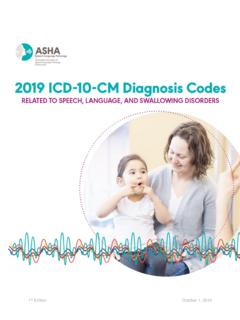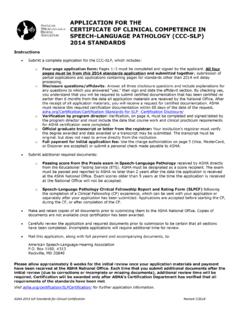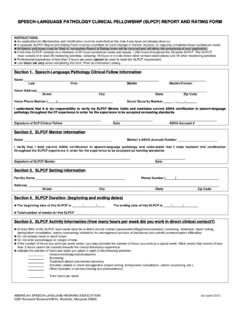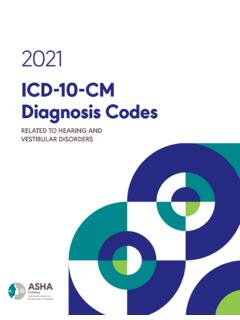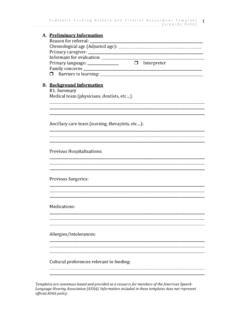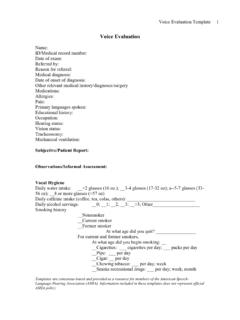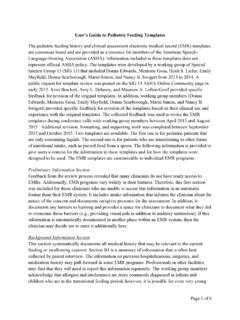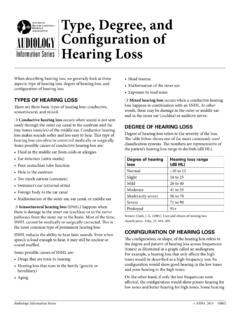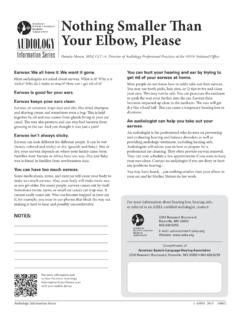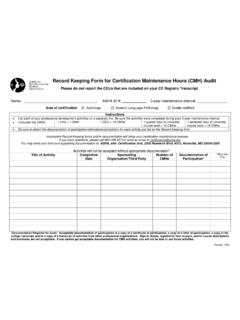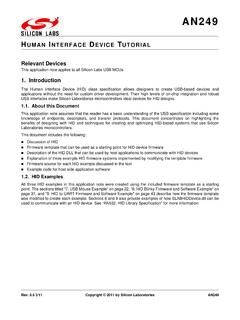Transcription of Interprofessional Education (IPE): What it is and why it ...
1 Interprofessional Education (IPE): what it is and why is it important?Elena M. Umland, PharmDCo-Director, Jefferson Center for Interprofessional EducationAssociate Dean and Professor, Jefferson College of PharmacyThomas Jefferson University, Philadelphia, PAProgram Goals Introduce the learner to IPE History Importance Present the development of a structured IPE program at one health-sciences university Use a case study to illustrate the impact of collaborative practice in the provision of patient careWhere we of Major Interprofessional Education & Collaborative Practice Literature201520132010200120031999To Err Is Human: Building a Safer Health SystemInstitute of Medicine, 1999 The Institute of Medicine reported that nearly 100,000 deaths occurred annually as a result of medical errors. Recommended interdisciplinary team training to increase patient safety and quality health care Crossing the Quality ChasmInstitute of Medicine, 2001 The 2001 IOM report identified deficiencies in the quality of health care received by Americans; 50 million Americans remain without health insurance.
2 All health professionals should be educated to deliver patient-centered care as members of an interdisciplinary team, emphasizing evidence-based practice, quality improvement approaches, and Professions Education : A Bridge to QualityInstitute of Medicine, 2003 Once in practice, health professionals are asked to work in interdisciplinary teams, often to support those with chronic conditions, yet they are not educated together or trained in team-based Future of Nursing: Leading Change, Advancing HealthInstitute of Medicine, 2010 Nurses should be full partners, with physicians and other health care professionals, in redesigning health care in the United Education for CollaborationInstitute of Medicine, 2013 Learning How to Improve Health from Interprofessional Models across the Continuum of Education to PracticeFramework for Action on Interprofessional Education & Collaborative PracticeWorld Health Organization, 2010 Defines Interprofessional Education (IPE) and collaborative practice (CP), noting relationship between the two and role Interprofessional collaboration will play in mitigating the global health workforce crisisTransforming Patient Care.
3 Aligning Interprofessional Education with Clinical Practice RedesignMalcolm Cox, MD and Mary Naylor, PhD, RN, FAANMacy Foundation 2013 Measuring the Impact of Interprofessional Education on Collaborative Practice and Patient OutcomesInstitute of Medicine, 2015 The impact of IPE on "patient safety, patient and provider satisfaction, quality of care, health promotion, population health, and the cost of Progress on the Institute of Medicine Report The Future of NursingInstitute of Medicine, 2015 Nurses need to lead and manage Interprofessional Collaborative EffortsInterprofessional Education (IPE) & Collaborative Practice (CP)WHO, 2010 Collaborative Practice When multiple health workers from different backgrounds work together with patients, families, caregivers, and communities to deliver the highest quality of care Interprofessional Education When students from two or more professions learn about, from, and with each other to enable effective collaboration and improve health outcomes WHO, 2010 Jefferson Center for Interprofessional Education Founded 2007 Mission:To promote excellence in healthcare through Interprofessional Education and scholarshipScope:Dedicated to implementing and evaluating Interprofessional Education and collaborative practice initiatives throughout Thomas Jefferson University curriculum Vision.
4 JCIPE will define the future of Interprofessional care by creating a culture of collaborative educational practice, setting the standards for patient-centered care and team-based trainingand becoming a national/international leader in developing an evidence base to support Interprofessional of IPE & CP IPE Core Competencies for Interprofessional Collaborative Practice developed in 2011 (IPEC) Communication Roles/Responsibilities Teamwork Values/Ethics IPEC updated in 2016 Interprofessional Collaboration IPE is now part of most accreditation standardsAccreditation RequirementsProgram Accrediting Body Requirement Citation Requirement Narrative Couple & Family Therapy The Commission on Accreditation for Marriage and Family Therapy Education (COAMFTE) Key Element IV B, FCA 9: Community Intersections & Collaboration Must develop competency in multidisciplinary collaboration Medicine Liaison Committee on Medical Education (LCME) Effective July 1, 2015 Standards 6 ( ) & 7 ( & ): Competencies, Curricular Objectives, and Curricular Design; Communication Skills.
5 & Interprofessional Collaborative Skills Must learn in environments permitting interaction with students in other health professions Curriculum must include specific instruction in communication skills relating to communication with patients and their families, colleagues, and other health professionals Curriculum must prepare students to function collaboratively on health care teams that include health professionals from other disciplines Nursing American Association of Colleges of Nursing (AACN) Essential VI (undergraduate) & Essential VII (graduate): Interprofessional Communication (and Collaboration for undergrads) for Improving Patient (and population for graduates) Health Outcomes Communication and collaboration among healthcare professionals critical to high quality care As a member and leader of Interprofessional teams, master s level nurse communicates, collaborates, and consults with other health professionals Occupational Therapy Accreditation Council for Occupational Therapy Education (ACOTE) Effective July 31, 2013 Standard Must effectively communicate and work interprofessionally with those who provide services to individuals, organizations, and/or populations in order to clarify each member s responsibility in executing an intervention plan Program Accrediting Body Requirement Citation Requirement Narrative Pharmacy Accreditation Council for Pharmacy Education Effective July 1, 2016 Standards 3 ( )
6 & 11 ( , & ): Approach to Practice and Care & Interprofessional Education Must be able to actively participate and engage as a healthcare team member by demonstrating mutual respect, understanding, and values to meet patient care needs Must demonstrate competence in Interprofessional team dynamics, including articulating the values and ethics that underpin Interprofessional practice, engaging in effective Interprofessional communication, and honoring Interprofessional roles and responsibilities. Interprofessional team dynamics are introduced, reinforced, and practiced in the curriculum Curriculum must include opportunities for students to learn about, from, and with other members of the Interprofessional healthcare team Must competently participate as a healthcare team member in providing direct patient care and engaging in shared therapeutic decision-making; participate in experiential educational activities with other student/professional healthcare team members, including face-to-face interactions that are designed to advance Interprofessional team effectiveness Physical Therapy Commission on Accreditation in Physical Therapy Education (CAPTE) Effective January 1, 2016 Standards 6F, 6L3 & 7D28 Curriculum must include Interprofessional Education .
7 Learning activities develop Interprofessional competencies including, but not limited to, values/ethics, communication, professional roles and responsibilities, and teamwork [effective January 1, 2018] Curriculum includes clinical Education that encompasses involvement in Interprofessional practice Curriculum includes content and learning experiences designed to prepare students to achieve educational outcomes required for initial practice of physical therapy. Courses within the curriculum include content designed to prepare program students to: Manage the delivery of the plan of care that is consistent with professional obligations, Interprofessional collaborations, and administrative policies and procedures of the practice environment Physician Assistant Accreditation Review Commission on Education of Physician Assistant (ARC-PA) Effective September 2014 Standard Curriculum must include instruction to prepare students to work collaboratively in Interprofessional patient centered teams (includes content on roles and responsibilities of various health care professionals, emphasizes team approach to patient centered care, assists with learning principles of Interprofessional practice and includes opportunities to apply these principles in Interprofessional teams within the curriculum) Council on Academic Accreditation.
8 Standards for Accreditation of Graduate Education Programs in Audiology and Speech-Language Pathology Standard Curriculum, Standard ..ensure that students have opportunities to acquire the knowledge and skills needed for entry into independent professional practice across the range of practice settings Instruction in prevention and identification / evaluation/ treatment of auditory and vestibular disorders must include opportunities for students to acquire the knowledge and skills necessary to Interact effectively with patients, families, other appropriate individuals, and professionalsCouncil on Academic Accreditation in Audiology and Speech- Language Pathology. (2014). Standards for accreditation of graduate Education programs in audiology and speech- language pathology (2008, revised 2014). Retrieved March 7, 2017 from Competencies: 2016 Update Work with individuals of other professions to maintain a climate of mutual respect and shared values.
9 (Values/Ethics for Interprofessional Practice) Use the knowledge of one s own role and those of other professions to appropriately assess and address the health care needs of patientsand to promote and advance the health of populations. (Roles/Responsibilities) Communicate with patients, families, communities, and professionals in health and other fieldsin a responsive and responsible manner that supports a team approach to the promotion andmaintenance of health and the prevention andtreatment of disease. ( Interprofessional Communication) Apply relationship-building values and the principles of team dynamics to perform effectively in different team roles to plan, deliver, and evaluatepatient/population-centered care and population health programs and policiesthat are safe, timely, efficient, effective and equitable. (Teams and Teamwork)Importance of IPE & CPImproved patient outcomesInterprofessional team training recommended to increasepatient safety and quality health care (Institute of Medicine, 1999)Increased patient satisfactionShown to increase patient satisfaction and improve the culture (Reeves, et al.)
10 , 2008)Decreased costsShown to reduce errors in the ED (Reeves, et al., 2008)Increased provider satisfactionAcknowledged role of workforce, importance of restoring joy, meaning to practice (Sinsky, et al., 2013)Addresses Quadruple Aim to improve health care quality through:Where we are Promote excellence in health professions Education and healthcare delivery through innovations in Interprofessional Education (IPE), collaborative practice (CP), faculty/staff development, assessment and scholarshipBarriers to IPE & CP Organizational and professional cultures Negative perceptions about utility Perception of add-on/extra work Role socialization from where we were Organizational structures Scheduling & space logistics Equal representation of professions Power imbalances Formal and informal Turf Wars A team of experts does not make an expert team Salas, et. al., 1992 IPE/CP Curriculum at JeffersonStep 1: InformedStep 2: KnowledgeableStep 3: CompetentAdvanced IPC Near Miss RCA Hotspotting No One Dies Alone ESHP Advanced TeamSTEPPS IPE/CP Scholarship IPE/CP FacilitationCore IPC Collaborative care: team-based rounding, huddles, debriefs, Teach-Back TeamSTEPPS Virtual ESHP Clinical Discharge Scenario Teamwork training electiveYear 2 HMP/Core IPEStep 4: Proficient*Adapted from Miller s Pyramid of Clinical CompetenceYear 1 HMP/Core IPEP rogram FeedbackFrom the moment we met we had a mutual understanding that although in different disciplines with different demands we would all work together at these assignments.
